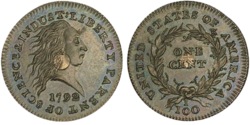
Back সিলভার সেন্টার সেন্ট Bengali/Bangla Centavo centro de plata Spanish Centesimo d'argento Italian

The Silver center cent is an American pattern coin[1] produced by the United States Mint in 1792. As a precursor to the large cent it was one of the first coins of the United States and an early example of a bimetallic coin. Only 12 original examples are known to exist,[2] of which one is located in the National Numismatic Collection at the Smithsonian Institution.[3] Two more specimens (Morris and California) exist but contain fabricated plugs added after minting.[4]
Due to their rarity and historical significance Silver center cents are highly prized by collectors with one graded PCGS MS61 being sold in an online auction in April 2012 for $1.15 million.[5][6]
- ^ "J1/P1". The Society of U.S. Pattern Collectors.
- ^ Garrett, J. & Guth, R. (2003). 100 Greatest U.S. Coins. Atlanta, GA: H.E. Harris & Co. p. 48. ISBN 0-7948-1665-7.
- ^ "Heritage Offering Finest Known 1792 Silver Center Cent at Jan. 2021 FUN Auction". Coin Week. November 30, 2020. Retrieved February 24, 2021.
- ^ 1792 SILVER AND NON-SILVER CENTER CENTS UPDATE. Vol. 22. E-Sylum. 2019. p. 26.
- ^
"1792 P1C One Cent, Judd-1, Pollock-1, High R.6, MS61 Brown PCGS". Heritage Auctions. Heritage Auctions, INC. 2012.
The Morris specimen traces its pedigree back to Charles Morris and its appearance in S.H. & H. Chapman's auction in April 1905.
- ^ "1792 Silver Center Cent Brings $1.15 Million To Lead Heritage Auctions' $29 Million+ Central States Event". Heritage Auctions. April 26, 2012. Retrieved February 24, 2021.
© MMXXIII Rich X Search. We shall prevail. All rights reserved. Rich X Search